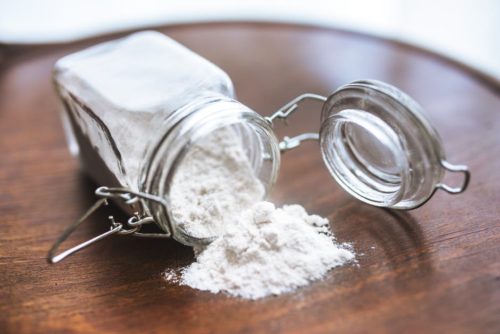Looking for an easy substitute for baking powder?
There are times when we find ourselves in a jam!
We might be planning on baking something only to find out that we’re missing all or part of an ingredient. In this case, you might be missing baking powder.
Baking powder is often used in bread and cakes to create volume during the baking process.
So what should you do if you need baking powder but don’t have it? How can you substitute for it?
Before running out to the store, glance through this article and see if you have any of these substitutes.
What is Baking Powder?
Baking powder is composed of sodium bicarbonate, which is a base (chemistry term!) and is paired with an acid, such as cream of tartar. Baking powder may also contain fillers like cornstarch.
When you mix baking powder with water, the acid in it reacts with the sodium bicarbonate in an acid-base reaction and releases a gas – carbon dioxide.
The mixture of baking soda with water is important because it reacts as soon as you mix it. That’s why you’re supposed to mix all dry ingredients together and all wet ingredients together before combining them.
This release of gas results in the formation of little bubbles and causes the mixture to expand. Which then adds volume to baked goods like cakes, breads, and waffles!
This not only adds volume but also texture to baked goods. It’s what makes baked goods light and fluffy.
Some people take this to another level by mixing their dough with club soda mixed with baking soda. And yes, club soda can add a lot of fluffiness to baked goods. It’s always best to experiment whenever you can.
Baking Powder Or Baking Soda – What’s the difference?
Baking Powder is often confused with Baking Soda. Don’t make that mistake!
Baking soda consists of only the base – sodium bicarbonate and is missing the acid component. Therefore, it must be combined with an acid that is a leavening agent (lactic acid or citric acid) in order to have the same leavening effect that baking powder does.
Types of Baking Powder
Single action and double action are the two types of baking powders available.
Single Action Baking Powder
Single action baking powder will only react once as soon as the liquid is added to the mix.
Double Action Baking Powder
Double action baking powder reacts just like single action as soon as it touches water, except it has an additional reaction to heat. So this second reaction happens during the baking process.
Because of these two reactions, double-action baking powder tends to give you fluffier, lighter baked goods.
The Best Baking Powder Substitutes
Before you keep reading, make sure you have Baking Soda! You can easily find a substitute for baking powder by combining baking soda and another ingredient.
Buttermilk
Buttermilk is a fermented dairy product with a sour taste that can be best compared to plain yogurt.
Because of its acidity, combining buttermilk with baking soda produces the same leavening and rising effect as baking powder.
Add 1/2 cup of buttermilk and 1/4 teaspoon of baking soda for every 1 teaspoon of baking powder needed.
1/2 cup buttermilk + 1/4 teaspoon baking soda = 1 teaspoon of baking powder.
It’s important to note, though, that when you add liquid of any kind, you must also reduce the other liquids in the recipe by that same amount of liquid, whether it be water or milk, or anything else.
It’s also important to note that buttermilk is NOT the same as sour milk.
Sour milk is milk that has lemon juice or white vinegar (but most likely lemon juice) added to it. This acid (lemon juice) causes fermentation to happen in the milk, creating sour milk.
Plain Yogurt
Yes, just like you can combine buttermilk with baking soda, you can also combine plain yogurt with baking soda to produce the same effect.
The same ratio that buttermilk uses can be used with plain yogurt.
1/2 cup buttermilk + 1/4 teaspoon baking soda = 1 teaspoon baking powder.
Yeast
Yeast can be a good alternative to baking powder because it forms bubbles and is often used in bread making to make bread rise.
If you’re going to use yeast as a replacement for baking powder, then you should follow the formula below.
Replace 1 teaspoon of yeast for every 2 cups flour that the recipe calls for.
Molasses
Molasses is formed as a by-product of making sugar and is often used as a replacement for refined white sugar. However, it can also replace baking powder.
This is because molasses is acidic enough to cause a reaction when mixed with the base – baking soda.
Use the formula below to guide your substitution.
1/4 cup molasses + 1/4 teaspoon baking soda = 1 teaspoon of baking powder
Basically, you substitute 1 teaspoon of baking powder with 1/4 cup molasses plus 1/4 teaspoon baking soda.
In this case, you might want to reduce the amount of sweetener in the recipe since molasses is extremely sweet already.
Self Rising Flour
Self rising flour is actually just a combination of all purpose flour, baking powder, and salt. This works only if your recipe calls for flour and baking powder.
The challenge of this recipe is that it’s difficult to control the portions and also adds gluten to the recipe.
Cream of Tarter
Cream of Tartar is also known as potassium hydrogen tartrate. It’s an acidic white powder that’s a by-product of winemaking.
It’s often used to stabilize creams and is an easy substitute for baking powder.
It’s best to stay to a 2:1 ratio of Cream of Tartar to Baking Soda in order to form baking powder.
Here’s the ratio,
1/2 teaspoon Cream of Tartar + 1/4 teaspoon baking soda = 1 teaspoon baking powder.
So basically, you substitute for 1 teaspoon of baking powder, a 1/2 teaspoon of cream of tartar plus a 1/4 teaspoon of baking soda.
Whipped Egg Whites
The process of using whipped egg whites is a pretty straightforward one.
Whipped egg whites have tiny air bubbles in them that increase volume and lightness in a baked good. This is a process often used in souffle, pancakes, meringues, and certain cakes.
It can be a good solid baking powder substitute and is a great option if you have no baking soda available.
The amount needed varies by recipe. A cake may need a dozen egg whites whipped or waffles may need just a couple.
To make the best of it, beat your egg whites at a low speed until they’re foamy and then increase the speed after that. That will ensure maximum fluffiness.
How to choose the best baking powder substitute?
To select the best substitute, keep in mind the flavor of what you’re trying to accomplish.
Molasses will have a strong sweetness to it. Therefore, you may want to use it on desserts rather than savory bread.
Cream of Tartar may be a good choice but it’s not something many people have readily available so you might have to go to the grocery store for it.
Egg whites are usually readily available but they’re more labor-intensive and they have an expiration date.
For some of these substitutes, you’ll have to use baking soda in addition to these other alternatives.
In addition to all of this, you might have to adjust other ingredients or amounts in your recipe to account for these substitutions.
We hope that we’ve made your life a little easier. That’s what we strive to do at Easy Kitchen Appliances. Not only do we review kitchen appliances, including some of the most innovative ones, but we want to make your cooking (and eating) life easier!
What other baking powder substitutes have you used?
Related Posts
-
How to Make Waffles Without Baking Powder, Eggs, or Milk
Are you looking for an Easy Belgian Waffle Recipe that has no Baking Powder, no…
-
How do you get burnt grease off a stainless steel pan?
How to remove baked-on grease from stainless steel pots and stainless steel pans? At Easy Kitchen…
-
10 Easy Breakfast Kitchen Appliances
Looking to make your life easy with some awesome breakfast kitchen appliances? I don't know…






